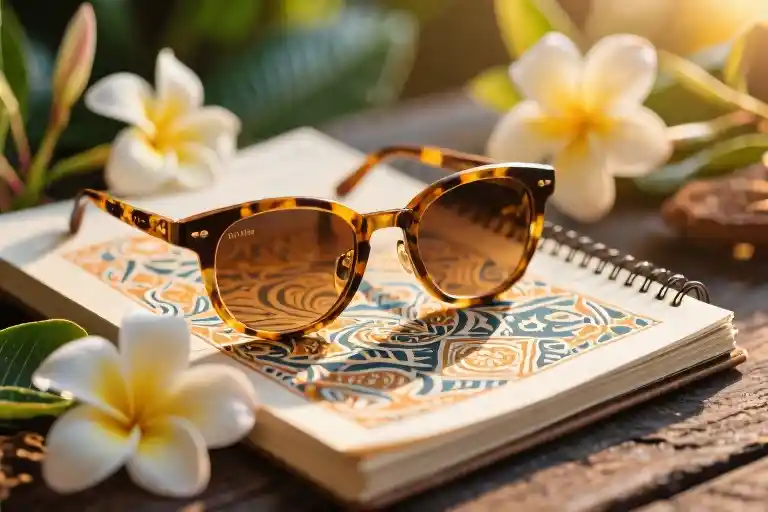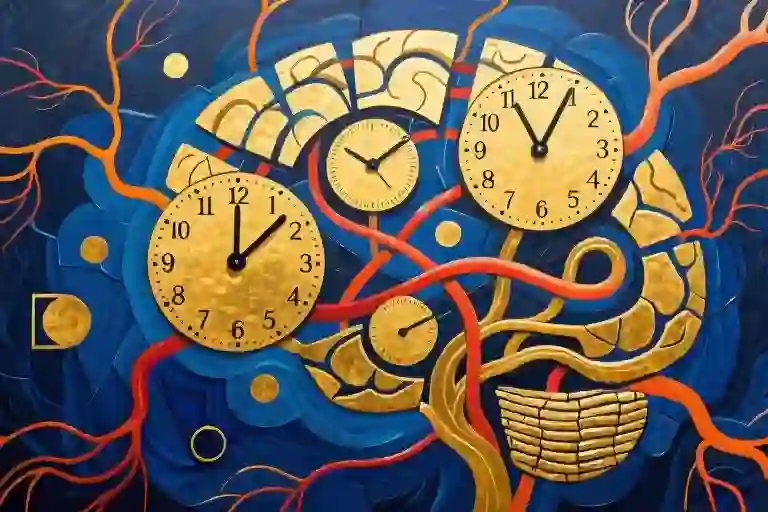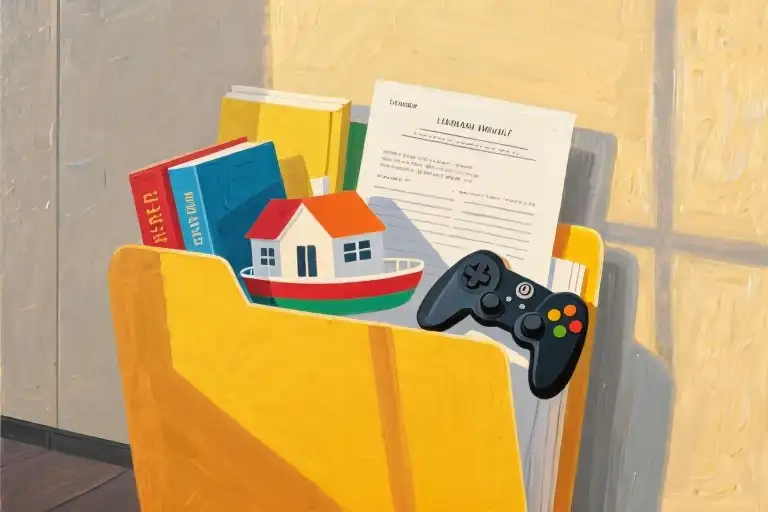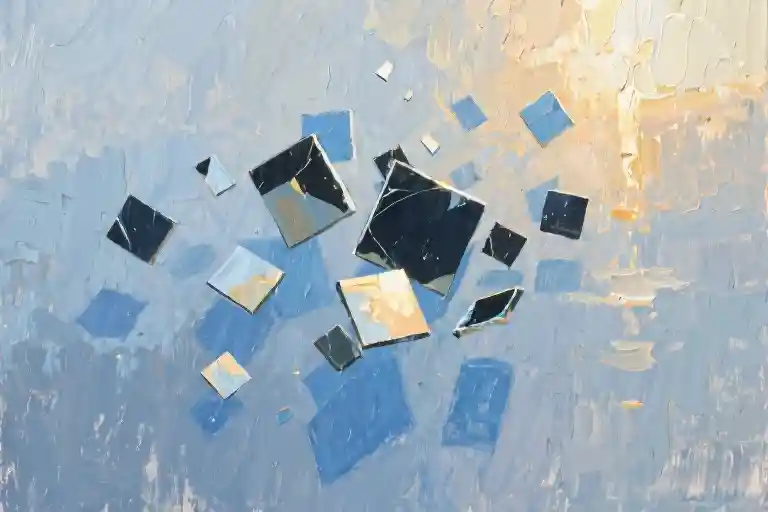The first crack in my understanding of beauty appeared on an ordinary afternoon when I was six. I remember the weight of oversized sunglasses slipping down my nose, the warm plastic frames resting precariously on my cheeks. Turning to my relatives with what I thought was a glamorous pose, their laughter hit me before the words did – “You have no nose bridge, the sunglasses outshine your face.”
In that moment, something shifted. The tropical sunlight streaming through the windows suddenly felt too bright, the cheerful chatter around me slightly distorted, as if I were hearing everything through water. My mother’s voice cut through the noise – “Almayra looks adorable, her nose is perfect” – but the damage had been done. I carefully removed the sunglasses, though the imprint of their judgment remained.
This became my first lesson in Indonesian beauty standards, though I wouldn’t have known to call it that then. Growing up in our archipelago nation, I’d later realize how beauty often felt like chasing the horizon – that narrow strip where sea meets sky that keeps receding as you approach it. The more I paddled toward it, the more elusive it became.
The sunglasses incident revealed three truths that would shape my coming-of-age:
- The Physics of Facial Features: How objects designed for certain face structures become instruments of measurement
- The Algebra of Approval: The unconscious calculations we make between laughter and compliments
- The Geography of Beauty: How our thousand islands seemed to have only one narrow shoreline where attractiveness was permitted to land
What nobody told me at six was that this moment would become foundational – not because it defined me, but because it began a series of questions I’d spend years unraveling. Why did certain facial structures earn praise while others prompted jokes? How had our collective imagination become so limited that we could recognize beauty in fictional blue aliens (when used as insult) but not in our own reflections?
Looking back now, I see how that childhood scene contained all the themes that would later emerge:
- The colonial ghosts lurking in casual remarks
- The protective power of a mother’s defiance
- The way objects (sunglasses, makeup, camera filters) become tools for both oppression and self-discovery
Most importantly, it marked my first unconscious realization that in our postcolonial landscape, beauty standards weren’t neutral – they carried the weight of history in their curves and angles. The same nose bridge my relatives joked about would later appear to me as a dotted line connecting personal insecurity to national narrative, individual faces to collective memory.
That afternoon with the slipping sunglasses became my origin story – not of insecurity, but of questioning. The beginning of understanding that decolonizing beauty starts with recognizing these microscopic moments of erasure, and that the journey back to oneself often begins when something refuses to stay comfortably in place.
The Moments That Slipped Away
That first sting came on an ordinary afternoon when I was six. The oversized sunglasses kept sliding down my face, their weight betraying what I didn’t yet know was called a “low nose bridge.” The adults’ laughter rang louder than their words – “The glasses outshine your face” – their chuckles etching my earliest memory of physical inadequacy. Only my mother’s voice cut through, insisting I looked adorable exactly as I was, though I’d already internalized the unspoken lesson: some facial architectures were designed to hold things better than others.
Years later, watching Avatar’s blue-skinned Na’vi, I recognized my nose curve mirrored in CGI perfection. The comparison wasn’t meant as praise – Neytiri’s alien beauty only underscored how my features deviated from human ideals. By eight, I’d developed what anthropologists call “the mirror gaze” – that split-second hesitation before reflective surfaces where we inventory perceived flaws before seeing our whole selves.
At fifteen, my Dutch-Indonesian cousin’s visit exposed deeper fractures. “Aren’t you insecure next to her?” my aunt asked, crystallizing the hierarchy I’d sensed but never named. Her innocent question carried centuries of colonial weight – the unshakable implication that mixed ancestry improved upon pure Indonesianness. Suddenly our childhood game of hom-pim-pa took on new meaning; no matter which way our palms turned, her European features always won.
Strangers’ mistaken assumptions became my secret metric of success. “Are you Japanese?” cashiers would ask, and I’d glow with misplaced pride. My teacher’s constant “so oriental” comments formed a perverse report card – each misattribution moving me higher on some invisible beauty leaderboard. The less Indonesian I appeared, the more validation I received, until I internalized the equation: proximity to whiteness equaled worth.
These micro-moments accumulated like sediment:
- The sunglasses incident (age 6) – First awareness of nasal hierarchy
- Avatar comparisons (age 8) – Recognition as “other” even among fiction
- Cousin’s visit (age 15) – Explicit mixed-race superiority messaging
- Mistaken identities (teens) – Reward system for ethnic ambiguity
Looking back, I see how these incidents formed a colonial beauty curriculum. The lessons weren’t in textbooks but in sideways glances, backhanded compliments, and the triumphant announcements when local celebrities married foreigners – always framed as “memperbaiki keturunan” or improving the bloodline. My face became a palimpsest, each layer overwritten with someone else’s standards until I could no longer read my own original text.
Yet within this erosion, small acts of resistance took root. My mother’s daily mantra – “Almayra anakku sayang cantik” – functioned as linguistic armor against the world’s aesthetic demands. The way my father would trace our matching eye shapes in family photos, creating an alternative genealogy of worth. These weren’t grand gestures but quiet counter-narratives that, over time, formed fault lines in my internalized beauty hierarchy.
What makes these childhood moments so potent isn’t their individual impact, but how they coalesced into an unshakable worldview. Like saltwater slowly reshaping coastline, each comment, comparison and backhanded compliment eroded my natural contours until I barely recognized my own reflection. Only now can I see how these seemingly isolated incidents were actually connected – beads on the same string of colonial beauty standards that still dictates so much of how we measure worth.
The Colonial Ghost in Whitening Creams
That moment in the drugstore aisle stays with me – fingers hovering over a brightening serum, the packaging gleaming with promises of ‘radiant transformation’. It wasn’t until I turned the bottle and caught the floral logo’s peculiar shape that the connection struck me. The embossed design mirrored the sailing ships in my high school history textbooks – the same vessels that brought more than spices to our shores 300 years ago.
The Portrait Gallery of Colonial Beauty
Dutch colonial portraits from the 1800s hang in Jakarta’s history museums like beauty instruction manuals. The oil paintings all share three unmistakable features: porcelain complexions (despite tropical humidity), narrow nasal bridges angled at precisely 115 degrees, and that peculiar jawline definition European artists insisted on painting. Fast forward to 2023, and these same measurements appear in the ‘facial golden ratio’ diagrams used by aesthetic clinics across Java. The beauty standard didn’t evolve – it was fossilized.
A recent analysis of 50 Indonesian beauty advertisements revealed 78% featured mixed-race models, while only 12% showcased distinctly Javanese or Sumatran facial features. The math becomes more disturbing when cross-referenced with census data – only 3% of Indonesians actually have Eurasian ancestry. This representation gap isn’t coincidence; it’s the visual manifestation of ‘memperbaiki keturunan’ – the colonial-era belief that intermarriage ‘improved’ native bloodlines.
The Plantation Ledger of Beauty
The phrase first appeared in 19th-century plantation records I discovered during university research. Dutch overseers documented marriages between European men and local women as ‘breeding projects’, with detailed notes on offspring’s skin tone gradations. One particularly chilling entry from 1867 praised a child for having ‘nearly passed the paper bag test’ – referring to the American segregation practice where those lighter than a brown paper bag received preferential treatment.
This toxic legacy now walks our streets in modern disguise. Last year’s viral TikTok trend #IndonesianNoseChallenge saw teens using contouring to create the illusion of higher nasal bridges, while dermatology clinics report a 140% increase in teen consultations for nose fillers since 2020. The most telling map isn’t in any geography textbook – it’s the cluster of premium aesthetic clinics concentrated in former Dutch administrative cities like Bandung and Surabaya, where rhinoplasty rates triple the national average.
The Chemical Afterlife of Colonialism
Examining ingredients lists becomes an archaeological dig. The bestselling ‘Heritage Glow’ whitening cream contains arbutin – a derivative of hydroquinone first synthesized by French chemists to lighten African colonial subjects’ skin. The ‘Diamond Radiance’ serum I nearly purchased lists ‘pearl extract’ as its hero ingredient, echoing the colonial pearl powder recipes wealthy Javanese women used to emulate their Dutch mistresses’ complexions.
Yet in laboratory reports, these ‘modern innovations’ show negligible difference from their 19th-century precursors. The real transformation occurs in our minds – where centuries of being told we need fixing calcify into self-hatred. When researchers at University of Indonesia surveyed 500 women, 89% could name at least three facial features they disliked, while 62% struggled to identify even one inherited trait they cherished.
This isn’t just about beauty standards – it’s about who gets to define normal. Every time we pick up that foundation shade named ‘Ivory’ instead of ‘Cinnamon’, every time we pinch our noses in mirror reflections, we’re not making independent choices. We’re following scripts written in plantation ledgers and colonial medical journals, performed with modern props.
The whitening creams will keep selling, the clinics will keep thriving, but I’m learning to read between their lines. When advertisements promise to ‘reveal your true beauty’, I now hear the unspoken second half: ‘by erasing your true self’. My ancestors survived forced labor and cultural erasure – the least I can do is resist this quieter violence against our mirrors.
The Linguistic Antidote: How My Mother’s Words Became My Armor
Growing up, my mother had this ritual of greeting me every morning with the same phrase: “Almayra anakku sayang cantik” (Almayra, my beloved beautiful daughter). At fourteen, I’d roll my eyes at what I considered embarrassing parental affection. Now at twenty-six, I recognize those words for what they truly were – neural pathways being carved through the dense forest of colonial beauty standards.
The Anatomy of a Healing Phrase
Linguists would call this affirmation priming – the way repeated positive statements can rewire self-perception. But in our Jakarta home, it was simply how love sounded before breakfast. Each component worked like precision medicine:
- Anakku (my child): Establishing belonging before beauty
- Sayang (beloved): Emotional safety as foundation
- Cantik (beautiful): The targeted counter to external否定
Research shows it takes 3-5 seconds for spoken words to integrate into our self-concept. My mother’s daily affirmation clocked in at 2.8 seconds – just enough time to bypass my teenage resistance.
My Father’s Eyes: A Genetic Inheritance
While my mother handled verbal reinforcement, my father provided visual evidence. Tracing our family photo albums became an archaeological dig for facial continuity:
- 1923: My great-grandfather’s immigration photo showing the same hooded eyelids
- 1967: Dad at university with my exact eyebrow arch
- 1999: Me at age four mirroring his squint when concentrating
This wasn’t just about resemblance. It was hard proof that features I’d been taught to see as flaws had survived generations for good reason. When Dutch colonial records described Javanese eyes as “sleepy and indistinct”, they failed to account for how perfectly these lids filter equatorial sunlight.
Constellations of Resistance
My mother’s freckles tell a different story. Where she saw “sun damage”, I began mapping constellations:
- The Orion cluster across her left cheekbone
- A miniature Big Dipper near her temple
- The Southern Cross formation I inherited on my right shoulder
We started a ritual using eyeliner to connect the dots during our weekly video calls from London to Jakarta. What began as playful bonding became conscious reclamation – transforming what dermatology calls hyperpigmentation into celestial navigation points.
The Family Feature Atlas
Last Eid, we created a digital archive that changed everything:
- Layer 1: Scanned childhood photos tagged with facial features
- Layer 2: Historical context (Great-Grandma’s nose surviving the Dutch famine)
- Layer 3: Scientific benefits (how our flat nasal bridges humidify tropical air)
Seeing our traits plotted across time and function shifted them from aesthetic characteristics to evolutionary achievements. The atlas now lives as a shared Google Drive folder we add to during family gatherings – our version of memperbaiki keturunan that actually improves the bloodline through celebration rather than correction.
The Ripple Effect
These practices created unexpected solidarity:
- My aunt began pointing out “the Soekarno jawline” in our cousins
- Little nieces now ask to “see the stars on Tante’s face”
- Our family WhatsApp floods with #WarisanCantik (beautiful inheritance) photos
What started as my mother’s stubborn refusal to let a child hate her reflection became multigenerational resistance. The tools are disarmingly simple – a phrase repeated, photos examined, dots connected. But their power lies in consistency, like monsoons eventually carving canyons through stone.
When researchers claim “it takes three generations to undo colonial trauma”, they forget to account for mothers who start the clock early with love that outpaces history.
The Feature Celebration Workshop
The 7-Day Self-Observation Challenge
The journey to reclaiming our beauty begins with simple acts of noticing. Here’s how to start:
Day 1: The Nose Chronicle
Take a profile photo of your nose bridge – not to critique, but to document its unique silhouette. Notice how it carries generations of tropical airflow adaptation.
Day 2: Lip Language
Apply lip balm slowly, tracing the borders your ancestors gifted you. Observe how their shape forms words in your mother tongue differently than others.
Day 3: Skin Tone Mapping
Photograph your inner forearm at three different times of day. Watch how the sunlight dances with your melanin like traditional gamelan rhythms.
Day 4: Eye Archaeology
Study old family photos to identify which relative’s gaze lives in your mirror. Notice how their survival stories shaped these eyelids.
Day 5: Hair Texture Appreciation
Braid a small section while recalling how this hair type protected scalps from equatorial sun for millennia.
Day 6: Facial Constellation
Chart your freckles or beauty marks as if mapping the Indonesian archipelago. Name each “island” after family traits.
Day 7: Full Moon Ceremony
Stand before a mirror at night with soft lighting. Whisper three feature affirmations in your local dialect.
Collecting Indigenous Aesthetics
- Batik Curves: Document the graceful lines in traditional wax-resist fabrics that mirror ideal facial proportions in Javanese culture.
- Wayang Silhouettes: Study the exaggerated profiles of leather puppets – what Westerners call “flat” features were deliberately amplified as divine.
- Sundanese Dance Hands: Film your fingers recreating traditional gestures. Notice how their elegant extension celebrates shorter phalanges.
#ProudIndonesianFeatures Visual Rules
- Lighting: Use golden-hour sunlight to showcase warm undertones
- Angles: Shoot from slightly below to honor our facial topography
- Accessories: Incorporate natural elements (frangipani, volcanic stone)
- Captions: Share which ancestor’s feature you’re celebrating
The Archipelago Constellation Project
We’re creating a collaborative map where:
- Each participant contributes one feature photo
- Images are plotted geographically
- Connecting lines form constellations celebrating regional diversity
Join by:
- Taking a close-up of your most “Indonesian” feature
- Tagging its origin (e.g., “Grandmother’s Balinese cheekbones”)
- Using #ProudIndonesianFeatures + your island name
Remember: Beauty isn’t about reaching some imagined shore – it’s about recognizing you’re already standing on sacred ground. Every feature tells an epic our textbooks never recorded.
The Final Liberation
Twenty years after that childhood moment with the sunglasses, I found myself holding the same pair—now vintage, still slightly bent. As I slid them onto my face, the metal arms rested differently against my skin. Not because my nose bridge had changed, but because my understanding of it had. The frames no longer “outshone” my features; they framed them like artifacts in a museum celebrating survival.
This time, when they slipped—because tropical humidity makes everything slippery—I caught them with a laugh. The sting had transformed into something softer, like the calluses on a guitarist’s fingers after years of practice. Those early moments of discomfort were the necessary friction that eventually made me resilient.
Declaration of Independence
Today, I’m proposing an “Aesthetic Independence Day”—not just for Indonesians, but for anyone who’s ever measured their reflection against someone else’s ruler. Here’s how it works:
- The Mirror Manifesto: Every morning for a month, name one feature you’ve been taught to dislike, then recite its origin story. My script goes: “This nose carried my ancestors through spice trades and monsoons.”
- Colonial Audit: Track your beauty consumption for a week. How many products promise to “correct” versus “celebrate”? My bathroom shelf now holds exactly zero whitening creams.
- Guerrilla Glamour: Take a style element from traditional wear (like batik patterns) and adapt it modernly. I pair my great-grandmother’s earring designs with graphic tees.
The Last Colony
Our faces are the final frontiers of decolonization. Not through surgery or filters, but by recognizing that every time we:
- Apply foundation to “brighten” our skin tone
- Contour to simulate bone structures our DNA never coded for
- Feel pride when mistaken for another ethnicity
…we’re replicating plantation ledgers that measured human worth by proximity to whiteness. True independence isn’t rejecting all influences—it’s consciously choosing which ones get to shape us.
The Homecoming
My mother’s old mantra—”Almayra anakku sayang cantik”—hangs above my mirror now in her handwriting. Some days, I add my own postscript: “My face is not a compromise between continents. It’s the exact right shape for holding all my stories.”
When people ask why this matters, I tell them: Beauty standards aren’t vanity—they’re the visible algebra of power. And in that equation, I’ve finally solved for X: my reflection, unapologetically Indonesian, gloriously ordinary, mathematically mine.





